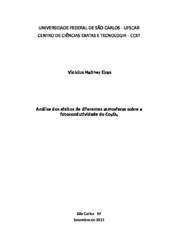| dc.contributor.author | Eiras, Vinícius Haither | |
| dc.date.accessioned | 2022-09-30T14:31:22Z | |
| dc.date.available | 2022-09-30T14:31:22Z | |
| dc.date.issued | 2022-09-22 | |
| dc.identifier.citation | EIRAS, Vinícius Haither. Análise dos efeitos de diferentes atmosferas sobre a fotocondutividade do Co3O4. 2022. Trabalho de Conclusão de Curso (Graduação em Engenharia Física) – Universidade Federal de São Carlos, São Carlos, 2022. Disponível em: https://repositorio.ufscar.br/handle/ufscar/16751. | * |
| dc.identifier.uri | https://repositorio.ufscar.br/handle/ufscar/16751 | |
| dc.description.abstract | In this monograph, the effects of different atmospheres on the photoconductivity of Co3O4 were analyzed. For this purpose, with a Co3O4 sample set inside a cryostat filled with the selected atmosphere, its photoresponse was measured, comparing the current flowing through it without any illumination with the current after the increase in electrical conductivity caused by the incidence of light. The atmospheres of atmospheric air, synthetic air, argon, nitrogen, oxygen and vacuum were chosen for this analysis. Considering the fact that Co3O4 has a double bandgap configuration, for each atmosphere two lasers of different wavelengths were used to illuminate the sample, aiming to excite the electrons from the valence band to the bands related to each bandgap separately. Comparing the photoresponse measurements for each atmosphere, a clear influence on the photoconductivity of the sample was noticed. For illumination with the two different wavelengths, considerably lower photoresponses and longer response times were obtained for atmospheres with oxygen and nitrogen gases when compared to argon and vacuum atmospheres. This is explained by the fact that oxygen and nitrogen react with Co3O4, adsorbing to its surface, capturing the free electrons and thus reducing the photoconductivity of the sample, while this does not happen for vacuum and argon atmospheres, as they are not reactive. The different photoresponses and response times obtained for different atmospheres indicate the possibility of using Co3O4 in applications such as gas sensors. | eng |
| dc.description.sponsorship | Não recebi financiamento | por |
| dc.language.iso | por | por |
| dc.publisher | Universidade Federal de São Carlos | por |
| dc.rights | Attribution-NonCommercial-NoDerivs 3.0 Brazil | * |
| dc.rights.uri | http://creativecommons.org/licenses/by-nc-nd/3.0/br/ | * |
| dc.subject | Óxidos | por |
| dc.subject | Oxides | eng |
| dc.subject | Fotocondutividade | por |
| dc.subject | Photoconductivity | eng |
| dc.subject | Semicondutores | por |
| dc.subject | Semiconductors | eng |
| dc.subject | Co3O4 | por |
| dc.title | Análise dos efeitos de diferentes atmosferas sobre a fotocondutividade do Co3O4 | por |
| dc.title.alternative | Investigation of atmospheres influence on the Co3O4 photoconductivity | eng |
| dc.type | TCC | por |
| dc.contributor.advisor1 | Godoy, Marcio Peron Franco de | |
| dc.contributor.advisor1Lattes | http://lattes.cnpq.br/2609654784637427 | por |
| dc.description.resumo | Neste trabalho foram analisados os efeitos de diferentes atmosferas na fotocondutividade do Co3O4. Para isso, com uma amostra de Co3O4 fixa dentro de um criostato preenchido com a atmosfera selecionada, foi medida a sua fotorresposta, comparando a corrente que a percorre sem nenhuma iluminação com a corrente após o aumento de condutividade elétrica causado pela incidência da luz. Foram escolhidas para essa análise as atmosferas de ar atmosférico, ar sintético, argônio, nitrogênio, oxigênio e vácuo. Considerando o fato do Co3O4 possuir uma configuração de bandgap duplo, para cada atmosfera foram utilizados dois lasers de comprimentos de onda diferentes para iluminar a amostra, visando excitar os elétrons da banda de valência para as bandas relacionadas a cada bandgap separadamente. Comparando as medidas de fotorresposta para cada atmosfera, percebeu-se uma clara influência na fotocondutividade da amostra. Para a iluminação com os dois comprimentos de onda diferentes foram obtidas fotorrespostas consideravelmente menores e tempos de resposta maiores para as atmosferas com os gases oxigênio e nitrogênio quando comparados com atmosferas de argônio e vácuo. Isso é explicado pelo fato de que o oxigênio e o nitrogênio reagem com o Co3O4, adsorvendo à sua superfície, capturando os elétrons livres e assim reduzindo a fotocondutividade da amostra, enquanto isso não acontece para as atmosferas de vácuo e argônio, por não serem reativas. As diferentes fotorrespostas e tempos de respostas obtidos para diferentes atmosferas indicam a possibilidade da utilização do Co3O4 em aplicações como sensores de gases. | por |
| dc.publisher.initials | UFSCar | por |
| dc.subject.cnpq | ENGENHARIAS::ENGENHARIA DE MATERIAIS E METALURGICA::MATERIAIS NAO METALICOS | por |
| dc.subject.cnpq | ENGENHARIAS::ENGENHARIA ELETRICA::CIRCUITOS ELETRICOS, MAGNETICOS E ELETRONICOS | por |
| dc.subject.cnpq | ENGENHARIAS | por |
| dc.subject.cnpq | CIENCIAS EXATAS E DA TERRA::FISICA::FISICA DA MATERIA CONDENSADA::TRANSP.ELETRONICOS E PROP. ELETRICAS DE SUPERFICIES;INTERFACES E PELICULAS | por |
| dc.subject.cnpq | CIENCIAS EXATAS E DA TERRA::FISICA::FISICA DA MATERIA CONDENSADA | por |
| dc.publisher.address | Câmpus São Carlos | por |
| dc.contributor.authorlattes | http://lattes.cnpq.br/1180448005682326 | por |
| dc.publisher.course | Engenharia Física - EFi | por |

